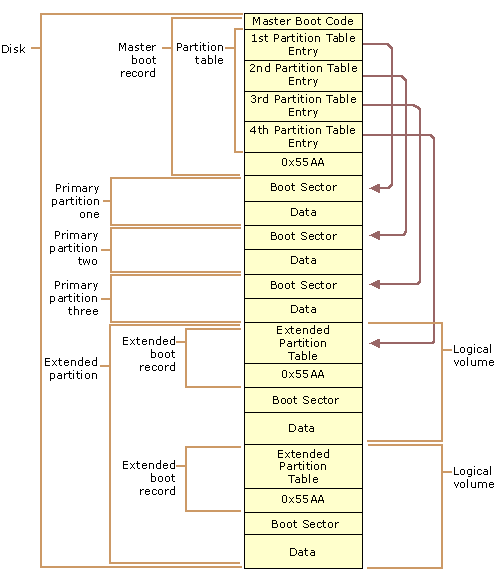File System - Partition / Volume (Logical Disk Partition)
About
Disk Drive can be divided with the help of the Operating systems file system into one or more logical disks called partition.
A partition is known for windows as volume.
To an application, a partition appears as an independent disk, even though that is not the case. The operating system provides a command for managing the size and locations of partitions on a disk. This command writes a partition map onto the disk in an area that is not visible to the application program.
A partition editor program can be used to create, delete or modify these partitions such as Gparted
The way that space management, access permissions and directory searching are implemented depends upon the type of file system installed on a partition.
Partition Table
This division is described in the partition table
Partition Types
Depending on type of system and what operating system is being used there are many different types of partitions.
Primary Partition
A partition that is used to start an operating system, although you can use primary partitions that don't contain the operating system.
There can be up to a maximum of four primary partitions on a single basic disk.
Extended Partition
A partition that can be sub-divided into logical drives. An extended partition is not formatted or assigned a drive letter. It's essentially a container for logical drives that are formatted and assigned drive letters.
You can get this information on linux with parted
parted /dev/sdb
GNU Parted 1.8.1
Using /dev/sdb
Welcome to GNU Parted! Type 'help' to view a list of commands.
(parted) print
Model: VMware, VMware Virtual S (scsi)
Disk /dev/sdb: 21.5GB
Sector size (logical/physical): 512B/512B
Partition Table: msdos
Number Start End Size Type File system Flags
1 32.3kB 21.5GB 21.5GB extended
Logical Drive / Logical Volume
A logical drive is created within an extended partition. An “unlimited” number of logical drives may be created in an extended partition, formatted.
Boot partition
A boot partition is defined as the partition containing the system files. For Windows NT, this is the partition containing the %SystemRoot%\System32 folder.
System partition
The system partition is defined as the partition containing the files needed for the initial system startup. For Windows NT, the files are Ntdetect.com, NTLDR, Boot.ini, and sometimes Ntbootdd.sys.
The system partition and boot partition can be on the same partition or on different partitions. Because there can be multiple operating systems installed on a single computer, a computer can have multiple boot partitions, but a computer has only a single system partition.
Quiz
Where should the Linux and Windows swap partition be located to provide the best performance?
- a. at the end of the drive
- b. in the middle of the drive
- c. at the beginning of the drive
- d. do not use a swap partition; use a swap file instead
Answer: c
